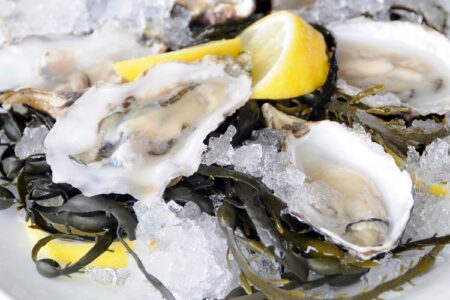Loved and loathed in equal measure, the satirist and author of Gulliver’s Travels, Jonathan Swift once said of the saltwater mollusc: “He was a bold man that first ate an oyster.” But if you were to put money on it, there’s a very good chance that man came from Cornwall.
Packed with minerals, low in fat and high in protein, oysters also contain as much iron as red meat. Small wonder they’ve been a Cornish staple since Roman times. But the oyster has been overfarmed in recent years, with many crops around the world fished to extinction, causing prices to skyrocket. In Cornwall producers and fishermen have become wise to this and are now at the forefront of creating a more sustainable way of farming and fishing.
Wild natives and Pacific farmers
Some of the UK’s last wild native oyster beds can be found in the river Fal near Falmouth. Fal’s fantastic oysters have recently won a protected designation of origin (PDO), the same European standard given to foods including Stilton cheese and Jersey Royal potatoes. Practically this means that the number of oysters caught is carefully monitored and only non-polluting sail boats (some over a century old) are used for fishing.
Closer to home, in the Camel Estuary between Padstow and Rock, you’ll find the very best Pacific oysters. Visit at the right time of day and you might even see these farmed varieties being gathered by local producers Tim and Luke of Porthilly Shellfish.
Making merroir
The special flavour of Cornish oysters is due in large part to geology, thanks to riverbeds that are rich in minerals. Another factor is the combination of salt and freshwater, making the Camel and Fal estuaries perfect for producing the most flavoursome varieties. Connoisseurs have a word for this: ‘merroir’, after ‘terroir’, the term used by wine producers to assess the regional environmental conditions which combine to create a delicious product.
If you’re on the hunt for oysters with the very best merroir, Padstow is the place to be. You’ll find numerous outstanding seafood restaurants like Rick Stein’s famous Seafood restaurant, and more relaxed joints like the Cally Oyster Bar. Another small, stylish eatery with a great reputation is Prawn on the Lawn, which also boasts a fishmonger.
Rock Oyster
Should you come to Padstow around the end of July, we highly recommend a visit to Rock Oyster, the annual seafood and music festival run by local restaurateur, Paul Ainsworth. This relaxed boutique event takes place on the banks of the Camel Estuary and is packed with well-known music acts and food from some of Cornwall’s finest producers and chefs.
Shucking oysters
Once you’ve taken your fresh, locally produced oysters home, what do you do with them? The fishmonger should have already ‘shucked’ (opened) your oyster but if not, cover with a cloth and take care when twisting that knife in the small opening.
Oysters can be served raw, flavoured with lemon, vinaigrette or a spicy Asian style dressing. You can also poach them and serve with pasta, or bake and top with a creamy, buttery sauce.
But if you’re still feeling nervous about the whole thing, go ahead and book a shellfish course at Rick Stein’s cookery school and go home a certified oyster expert.




